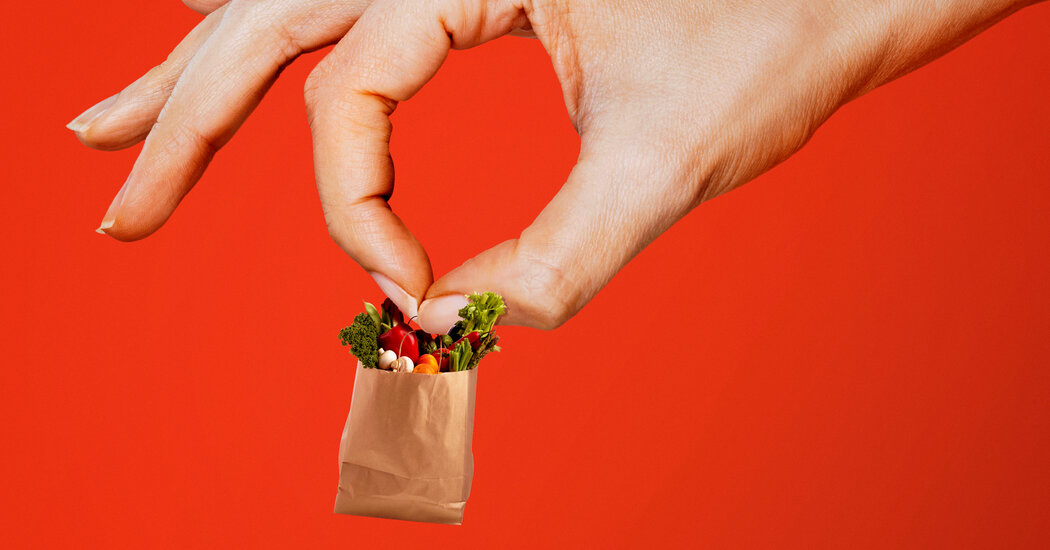March 1, 2024 | by Kaju

Grocery retailer customers are noticing one thing amiss. Air-filled luggage of chips. Shrunken soup cans. Diminished detergent packages.
Firms are downsizing merchandise with out downsizing costs, and shopper posts from Reddit to TikTok to the New York Instances feedback part drip with indignation on the pattern, broadly generally known as “shrinkflation.”
The observe isn’t new. Sellers have been quietly shrinking merchandise to keep away from elevating costs for centuries, and specialists suppose it has been an apparent corporate strategy since at the very least 1988, when Chock Full o’Nuts reduce its one-pound espresso canister to 13 ounces and its opponents adopted go well with.
However outrage right now is acute. President Biden tapped into the angst in a recent video. (“What makes me probably the most offended is that ice cream cartons have truly shrunk in dimension, however not in value,” he lamented.) Firms themselves are blasting the observe in advertising gimmicks. One Canadian chain unveiled a growflation pizza. (“In pizza phrases,” the corporate’s information launch quipped, “a bigger slice of the pie.”)
However how does shrinkflation work, economically? Is it taking place extra usually in the USA, and in that case, does that imply official knowledge are failing to seize the true extent of inflation? Beneath is an explainer of the pattern — and what it means to your pockets.
Shrinkflation was rampant in 2016.
It is likely to be exhausting to consider, however shrinkflation seems to be taking place much less usually right now than it was a couple of years in the past.
The federal government adjusts official inflation knowledge to account for product downsizing, and the information collectors who monitor for dimension changes caught fewer situations of shrinking family items and groceries in 2023 than a couple of years earlier.
Downsizing was frequent again in 2016, when total inflation was low. It turned rarer after the beginning of the pandemic in 2020, and extra not too long ago it has begun returning to prepandemic ranges, analysts from the Bureau of Labor Statistics stated. (The economists famous that the set of merchandise being measured modified considerably through the years, making comparisons throughout time extra a tough approximation than a precise science.)
However the magnitude for some merchandise is extra excessive now.
Even when downsizing will not be taking place as usually, shrinkflation right now is having a big effect in a couple of key classes, together with sweets, detergent and bathroom paper.
From 2019 to 2023, shrinkage added about 3.6 proportion factors to inflation for merchandise like paper towels and bathroom paper, up from 1.2 proportion factors from 2015 to 2019. Shrinkflation has additionally contributed extra closely to cost will increase in each sweet and cleansing merchandise in recent times.
For snacks, shrinking sizes added 2.6 proportion factors to inflation, roughly in keeping with how a lot they contributed from 2015 to 2019. The federal government has not but launched an evaluation on how a lot shrinkflation contributed to total inflation from 2019 to 2023.
Whereas ‘shrinkflation’ will get measured, ‘skimpflation’ doesn’t.
Shrinking itself is captured in official inflation knowledge, however one other sneaky drive that prices customers is getting missed within the statistics. Firms typically use cheaper supplies to save lots of on prices in a observe some name “skimpflation.” That’s a lot more durable for the federal government to measure.
In case your paper towel roll prices the identical however you’re getting fewer sheets — shrinkflation — that exhibits up clearly as a unit value improve that’s added to official inflation. In case your paper towels are the identical dimension however are out of the blue made from worse materials — skimpflation — the federal government doesn’t file that as inflation.
In truth, meals and family merchandise broadly usually are not immediately adjusted for high quality modifications aside from dimension and weight, authorities statisticians stated. So in case your microwave dinner model begins utilizing vegetable as a substitute of olive oil, or in case your previously resealable package deal loses its zipper, that received’t present up.
Firms do that as a result of it really works.
Firms select to shrink their merchandise relatively than cost extra for a easy cause: Customers usually pay extra consideration to costs than sizes.
When amount goes down, “folks may discover, however usually, they don’t,” stated John Gourville, a professor at Harvard Enterprise College. “You don’t get sticker shock.”
In a single well-known instance, Dannon used to promote yogurts in bigger containers than its competitor Yoplait — eight ounces versus six. Customers had been satisfied that Dannon’s yogurt was costlier, not choosing up on the truth that it was merely greater. Ultimately, Mr. Gourville stated, the corporate caved and shrank its packaging.
“Gross sales of Dannon’s yogurt, which declined instantly after the dimensions discount, have since rebounded,” The Instances reported in 2003. “And Dannon is now pocketing a bigger revenue on each cup of yogurt it sells.”
Not all dimension modifications are created equal. Some may be surreptitious, like growing the dimensions of an indentation within the backside of a jar or shaving the corners from a bar of cleaning soap. Customers have a very tough time recognizing dimension modifications after they occur alongside three dimensions, stated Nailya Ordabayeva, an affiliate professor at Dartmouth’s Tuck College of Enterprise who has studied shopper responses.
“The mind is hard-wired to do easier heuristics,” she defined.
Plus, she famous, customers is likely to be keen to just accept smaller portions and even favor them in some instances. Junk meals merchandise have at instances shrunk to get down calorie counts, for instance.
Nonetheless, customers may push again.
When corporations are merely taking care of their earnings — not their customers — some pricing specialists fear that persistent shrinkflation might drive customers away.
When uncooked materials prices had been climbing and inflation was within the headlines, customers almost definitely understood that corporations wanted to cross a few of these will increase alongside. They might even have most well-liked smaller merchandise to larger value tags, a number of specialists stated.
However now, total inflation has been cooling: After peaking at 9.1 % in July 2022, it had eased to three.1 % as of January. And customers is likely to be much less keen to just accept shrinkflation now that corporations are dealing with much less extreme value pressures, particularly as a result of meals firm earnings have been — and in many cases remain — excessive.
They might merely really feel ripped off.
“I can see customers changing into increasingly more conscious of the existence of shrinkflation,” stated Jun Yao, a advertising lecturer at Macquarie College in Australia who has studied the pattern.
And as extra chains and on-line retailers put up unit prices, customers could also be extra attuned to dimension modifications, Mr. Yao stated, an consciousness that might beat again towards future shrinkage.
The observe, he stated, “can backfire — and injury the model picture.”
RELATED POSTS
View all


